State of Howard County Public Schools 2020
Presented by HCPSS Superintendent Dr. Michael Martirano
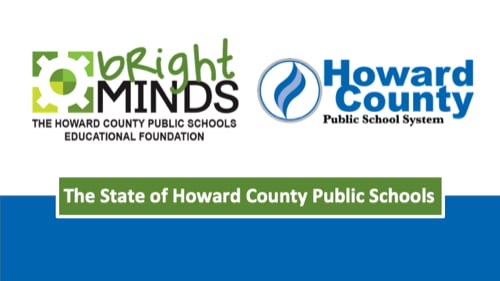
Introduction
Good afternoon. It is an honor and pleasure to present to you the State of the Howard County Public School System.
I would like to thank all of you for attending this special and important occasion. It truly shows your commitment to public education. Howard County is rich in many ways, but I believe our most valuable resource is our dedicated, caring community. Our school system enjoys a level of community support that would be the envy of most other school systems.
This morning, I am going to touch on many of our priorities and continuing efforts to develop and implement a birth-to–12 continuum, aimed to ensure that 100% of our students earn a high school diploma or certificate of completion and are fully prepared to enter life after high school. I will begin this presentation by detailing my priorities and the ways we are fulfilling each of these important initiatives, and then share the four major areas that anchor our equity work.
Our top priority has always been, and always will be, students. Because of that, I’m going to start with them in mind.
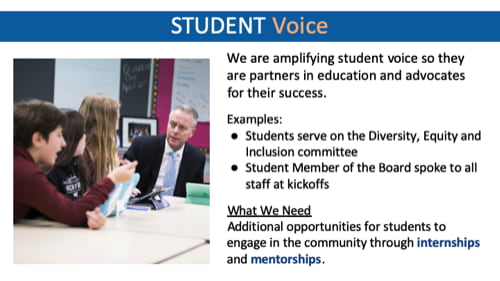
Student Voice
This August I joined every HCPSS staff member to welcome in the new school year at twelve separate kickoff events. Kickoff has become a tradition that I thoroughly enjoy. For the first time, we elevated student voice to the forefront of our kickoffs, as Allison Alston, our Student Member of the Board, delivered the powerful and inspiring speech that you just witnessed. Allison’s message was viewed and shared by thousands of people online. It was a shining example of the influence that a student’s voice can have if we provide them with the right platform.
Finding opportunities to partner with students to influence their educational outcomes remains a priority. Students serve on all Board policy committees as well as the Diversity, Equity and Inclusion committee.
Allison continues to be a tremendous advocate for students, and she is developing leadership capacity in her peers, so they can continue to advance the wonderful work she has begun.
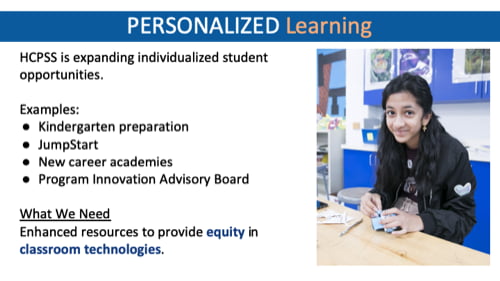
Personalized Learning
HCPSS continues to expand learning opportunities to align with students’ individual strengths, needs, skills and interests. Examples include:
- Programs supporting families of children ages birth through 5;
- JumpStart;
- New agriculture, HVAC and apprenticeship academies; and
- Continuing support from the Superintendent’s Program Innovation Advisory Board.
To fulfill our commitment to providing enhanced learning and career options for all students, we need significantly more resources to provide equity in classroom technologies across the county.
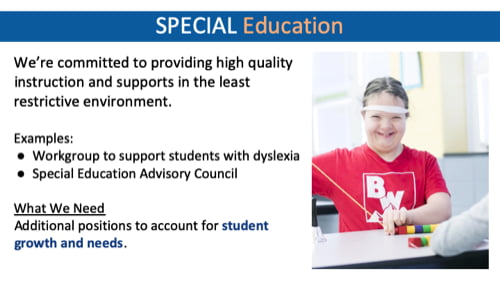
Special Education
The Howard County Public School System acknowledges and supports the rights of all students to receive a free, appropriate public education that will enable them to develop their unique talents and abilities, thus preparing them to participate in and serve their community with dignity and pride.
We’re committed to ensuring students needing special education services receive high quality instruction and supports in the least restrictive environment, with full collaboration among staff, families and community providers. Unfortunately, more and more students are requiring special education supports and our special educators are becoming overwhelmed.
Later in this presentation, I will provide more detail from my recently proposed FY 2021 Operating Budget, which aims to strengthen specialized services for students with developmental and intellectual disabilities. By adding over 200 teacher, paraeducator, and student assistant positions, we will be better able to support student growth and program and placement needs from birth through Age 21, and align staffing with recommended levels.
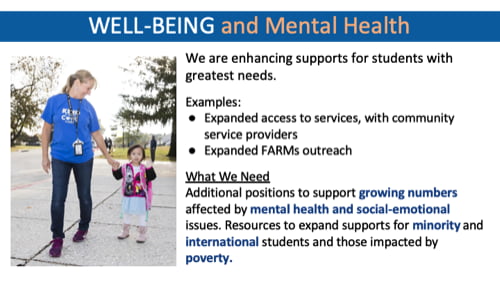
Well-being and Mental Health
Even in a county as affluent as Howard County, more than 22 percent of HCPSS students live in poverty, and many more face language barriers, mental health issues and other challenges that hinder learning and achievement.
We are continually enhancing supports for students with the greatest needs by adding special educators, social workers, pupil personnel workers and nurses in schools, expanding access to essential services in collaboration with community service providers, and encouraging families in need to sign up for the benefits included in the Free and Reduced Meals program.
To continue to provide the supports at a level that our community has come to expect, we need additional school social workers, psychologists, counselors, nurses and others, to begin a 6-year process to support growing numbers of students and staff affected by poverty, mental health, social-emotional and behavioral issues.
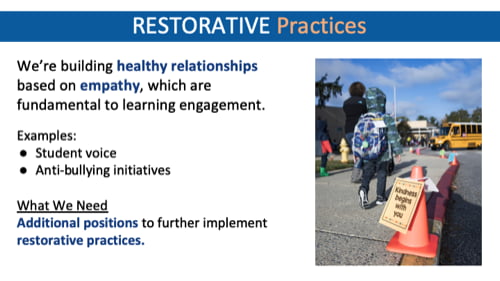
Restorative Practices
Restorative practices are at the core of our long-term strategy for achieving higher levels of student engagement and achievement, narrowing achievement gaps among student groups, and ensuring nurturing, inclusive and safe learning environments for all students. We have elevated “student voice” as a fundamental strategy for schools to establish a restorative climate.
To give our work more permanency and sustainability, I proposed adding three positions to accelerate implementing and institutionalizing restorative practices and equity work into our curriculum and culture. These positions were represented in my recently proposed operating budget.
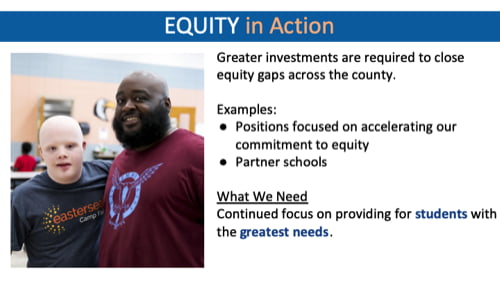
Equity in Action
My proposed Operating Budget to the Board of Education amplified equity and prioritized investments to tend to our students with greatest needs. As I mentioned, I’ve prioritized adding several positions to support our schools and focus on accelerating equity for students and staff.
Other initiatives are underway to enhance equity without adding budget dollars. For example, Partner Schools is one new initiative, which involves pairing two schools to enrich the connection between communities. All schools have strengths; and this program will enable schools to share their strengths with one another and to enhance and celebrate diversity. Partner schools may collaborate around community activities, culture building, sharing instructional practices, school-wide best practices, and more. Several schools have already embraced similar models of partnering, such as Triadelphia Ridge and Bryant Woods elementary schools, and Folly Quarter Middle and Homewood schools.
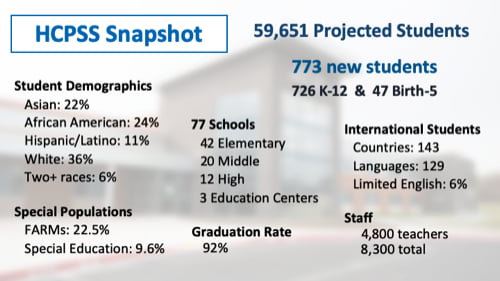
HCPSS Snapshot
Our school system enjoys a unique confluence of assets: strong community support, a premier team of educators, and well-maintained schools and facilities. These attributes make our community one of the most sought-after destinations for education in the nation. At the same time, it contributes to rapid enrollment growth. Howard County is one of the fastest growing school systems in Maryland. We expect to welcome 773 new students to our classrooms next year, bringing our student population to a projected 59,651, up from 58,878 today. We have every reason to expect additional growth will continue each year for the foreseeable future.
We have 77 schools and are fortunate to have a wonderfully diverse student body. Over 22 percent of our students receive Free or Reduced Meals (FARMs), which is a measure of poverty and approximately 600 students are homeless. 9% receive special education services. Our students represent 143 different countries and speak 129 different languages.
We are Howard County’s largest employer, with more than 8,000 full- and part-time employees including 4,800 teachers.
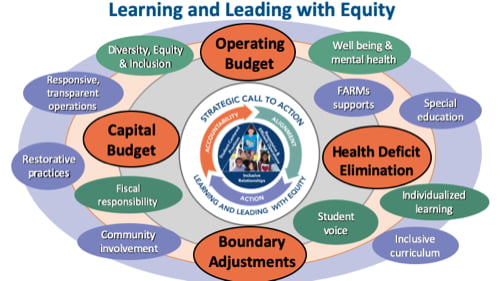
Learning and Leading with Equity
The phrase “Learning and Leading with Equity” in the title of our Strategic Call to Action sums up in 5 words all of the work we do in our school system, every day to give each of the children in our care the best possible prospects for a rewarding and satisfying life.
Our overall strategy for putting equity into action is anchored by our Operating Budget, Capital Budget, Health Fund deficit elimination and our school Boundary Adjustment process. These four areas are inextricably linked and augmented by all of our initiatives in restorative practices, lifting up student voice, supporting children and families struggling with poverty, mental illness and other needs, and our other priorities.
All of these work together to fulfill the imperative of equity and targeted outcomes embedded in our Strategic Call to Action.
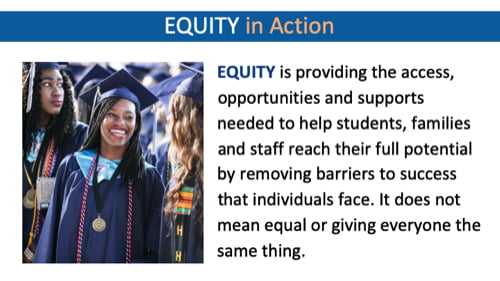
Defining Equity
I want to talk about our definition of equity, because that is what drives us every day. Equity is at the center of how we approach our operating and capital budgets, health deficit, and boundary adjustments. We strive for “equity,” rather than “equality” because each student and staff member has unique challenges and requires individualized services and supports to achieve goals.
We’re ensuring equity is woven into all school system practices, resources and opportunities; and we use a common definition and language for equity among all HCPSS stakeholders. Specific efforts include: a commitment to equitable discipline practices, increasing staff diversity, and embedding diversity and inclusion throughout the curriculum.
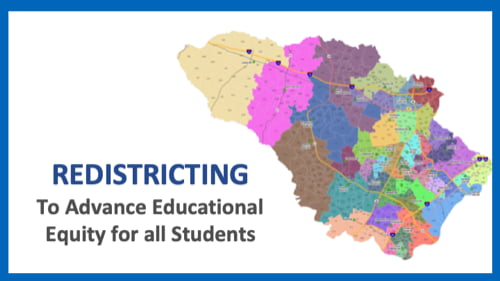
Redistricting
This fall, HCPSS performed a comprehensive review of school attendance areas, and the Board of Education voted on a subsequent redistricting decision. Driven by the foundation of providing equitable opportunities across the county, the purpose of the process was three-fold:
- Relieve crowding in our most overcrowded schools,
- Reduce the Free and Reduced Meals (FARMs) rate at schools where it is above the county average, and
- Prepare for the opening of High School #13 in 2023.
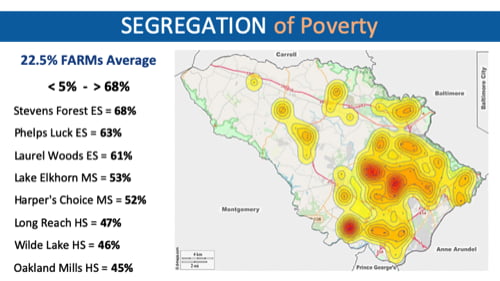
Segregation of Poverty
When I began the process of evaluating the attendance areas in preparation for my recommendation to the Board, it became apparent that not only does Howard County have a school capacity problem, but also a serious imbalance in the proportion of students who face greater challenges. The Free and Reduced Meals – or FARMs – program is the socio-economic indicator widely used in public education. While the FARMs rate for the 2019–2020 school year is 22.5% countywide, the distribution of FARMs varies considerably across schools, from less than 5% in some schools to well above 60% in others.
Additionally, the concentration of poverty in certain areas of the county, as shown by the heat map, creates additional challenges for the communities and schools in those areas.
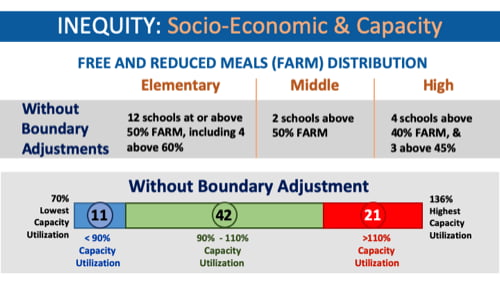
Inequity: Socio-Economic and Capacity
Without boundary adjustments, 21 of our schools had a FARMs rate over 40%, essentially double the county average. Additionally, 32 schools were outside the capacity utilization targets as defined by Board policy, with 21 schools over capacity.
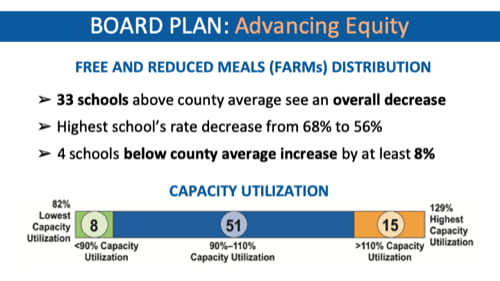
Board Plan: Advancing Equity
When the redistricting plan goes into effect in the 2020–2021 school year, 5,402 students will be moved to a new school.
The Board’s plan prioritized the need to address capacity differences across many county schools. Fifty-one schools will be within the 90–110 percent target capacity utilization defined in Board policy, compared with 42 currently, and many of the most highly-impacted schools will see significant relief.
The decision also advances socioeconomic equity by addressing the proportion among schools of students receiving Free and Reduced Meals program services.
- 33 total schools above the countywide average of 22.5 percent will see an overall decrease in their FARMs percentage as a result of these moves.
- 13 of these 33 schools will experience a 5–22 percentage point decrease in their FARMs rate.
- The FARMS percentage for four schools below the countywide average will increase by a minimum of 8 percentage points, putting them closer to the countywide average.
I commend the Board of Education for making a difficult decision – grounded in equity – that so many previous Boards did not make.
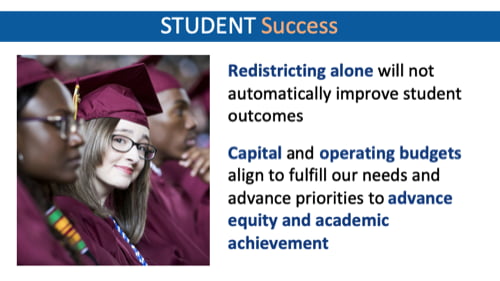
Student Success
The Board’s recent decision on redistricting represents a significant course correction for our system in fulfilling the values for equity embodied in our Strategic Call to Action. However, redistricting alone will not automatically improve student outcomes.
Our Capital and Operating budgets are connected to redistricting to fulfill our needs and move forward, advancing our priorities of equity and academic achievement.
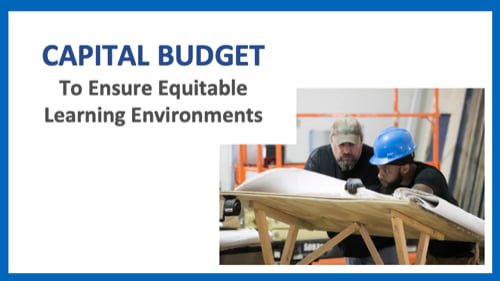
Capital Budget
The school system’s Capital Budget funds the construction of new school facilities and provides for renovations, additions, roofing and barrier-free projects, technology equalization, and the purchase or relocation of portable classrooms for existing facilities. Financing for capital projects comes primarily from three sources: local bonds, local transfer tax and state school construction funds.
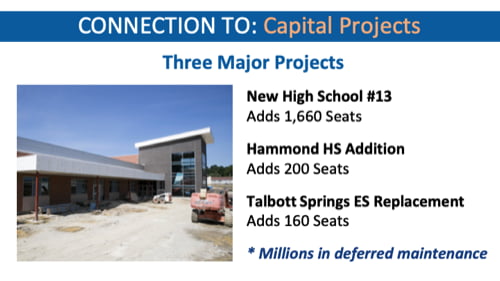
Capital Projects
The Board’s Proposed Capital Budget for FY 2021 prioritizes three major projects that have become critical needs of our school system. These projects include construction of a new 13th county high school, targeted to open in fall 2023; an addition to Hammond High School, scheduled for completion in fall 2023; and a replacement for Talbott Springs Elementary School, scheduled for completion in fall 2022. The proposals address projected student capacity and existing facility needs in order to relieve crowded schools and support rapid enrollment growth.
Additionally, we currently have millions of dollars in deferred maintenance that must be addressed as buildings and systems continue to age and require repair and replacement.
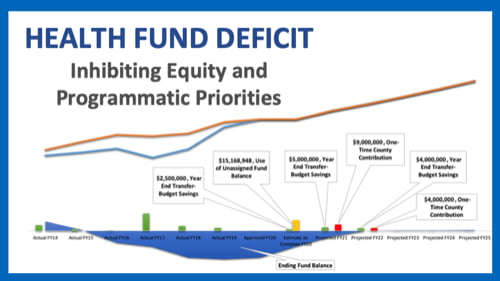
Health Fund Deficit
The Health Fund deficit is a dark cloud hanging over all of our budget planning. The deficit, currently at $39.2 million, is the result of decisions made prior to my tenure, to underfund staff health care costs so that funds could instead be used to pay for the service and support enhancements that our community values. Those decisions have limited our ability to advance priorities for programs and services that support student achievement and well-being. It is absolutely critical that we eliminate this deficit so our budget can be driven by the supports our students and staff need, and not by this dark cloud.
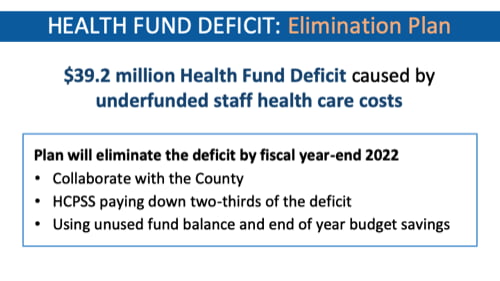
Health Fund Deficit Elimination Plan
The most recent school system audit delivered an adverse opinion, based on a lack of progress in addressing the health fund deficit. The adverse audit opinion is rare, and is a blemish on our school system and our County government. Avoiding a second adverse opinion next year requires a firm and collaborative commitment to substantially reduce the deficit in the near term, and to completely eliminate it over the next few years.
We have established a plan for eliminating the remainder of the deficit by fiscal year-end 2022. The plan proposes to collaborate with the County, with HCPSS paying down two-thirds of the deficit and the County contributing one-third. This would be achieved through a combination of one-time funding from the County and year-end transfer of budgetary savings in the General Fund.
I want to emphasize: The deficit was caused by prior leadership decisions, and not by employees’ actions. Therefore my plan does not ask employees to pay more to eliminate the deficit. The fact that the deficit was set in motion years ago does not absolve us of our responsibility to balance our budget. The deficit hamstrings our system’s ability to advance our priorities for equity and program enhancement.
I am determined that a hallmark of my legacy as superintendent will be the elimination of this deficit. I cannot overstate the urgency of this responsibility, because it has grave and long term implications. We must commit to making the difficult choices that are the only way to set our system on a sustainable fiscal path.
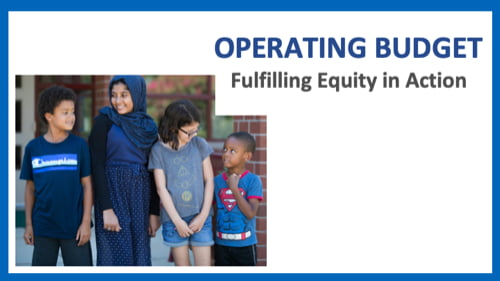
Operating Budget
My recent Operating Budget proposal for school year 2020-2021 articulates the funding needed to maintain support for students, staff and schools while accounting for enrollment growth.
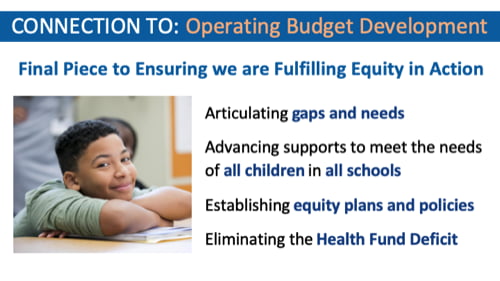
Operating Budget Development
The proposal describes all of the programs, aligned with the HCPSS Strategic Call to Action, that fulfill every child’s basic right to equitable opportunities to learn, grow and achieve. It lays out in detail how funding is carefully allocated among programs and strategies that put equity into action to give every child access to the quality educational services and supports needed to stay on track to graduation and lifelong success. As I’ve mentioned, the proposal also includes budget-neutral realignments to advance our critical work to advance equity and address severe understaffing in special education.
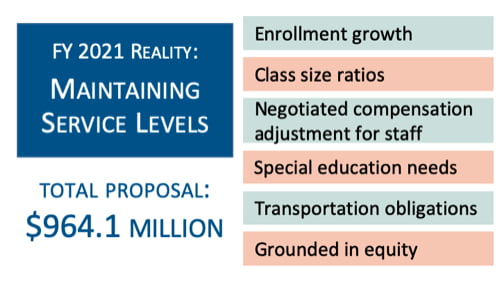
Maintaining Service Levels
The FY 2021 Budget recommendation totals $964.1 million, representing an increase of $62.7 million, or 7%. We understand the gap that exists between the needs of the school system and the available funding anticipated for FY 2021, as preliminary conversations with county staff indicate that county revenue growth is expected to be 2–3% above FY 2020 levels.
My proposed budget details exactly what is needed simply to maintain current levels of service, while accommodating enrollment growth, meeting Board commitments, and addressing critical needs in special education. Additionally, we have nearly $70 million in program and service gaps that have been identified but not advanced to the Board as part of my proposal.
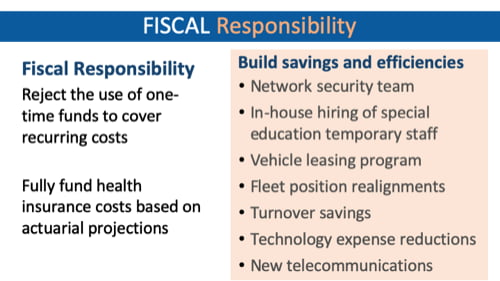
Fiscal Responsibility
In preparing this budget proposal, I maintained several principles that are critical to ensuring fiscal integrity for our school system. I consider these to be non-negotiable:
- One-time funds should not be used to cover recurring costs, and
- Always fully fund health insurance obligations.
Additionally, we identified several opportunities to realize cost savings and efficiencies, including:
- Forming a budget-neutral IT Security Team,
- Bringing the hiring process for special education temporary employees in-house,
- Increasing efficiency and avoid repair and maintenance costs with a vehicle leasing program, and realign fleet management into a single budget program to increase efficiency and add savings,
- Leveraging greater precision and analysis of historical trends of actuals to increasing estimated turnover savings by $991 thousand,
- Realizing a $1.1 million reduction in technology expense reflecting a modification in budgeting for depreciation, and
- Replacing our aging phone system with a more reliable system to ensure dependable communication.
The recently proposed budget exemplifies fiscal responsibility and demonstrates austerity in how we eliminate the deficit and continue to look for ways to innovate and improve in a fiscally responsible manner.
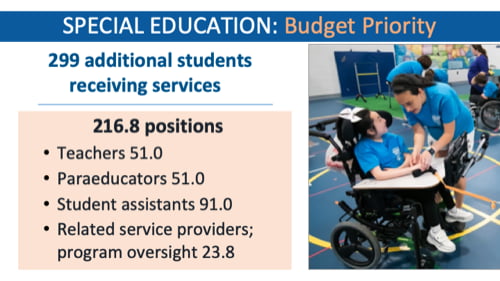
Special Education Budget Priority
For Special Education, we have a 299 projected increase in students receiving services. This includes 121 new students ages Birth–5, and 178 for Kindergarten–age 21.
Special Education was a priority of my FY 2021 budget proposal. The urgent need for additional staffing and supports for special education was brought into sharp relief during a recent Board meeting, when several of our special education teachers courageously stepped forward to describe the difficulties they experience in their roles. My heart ached as they spoke of the heavy strain from trying to educate while addressing students’ needs without adequate staff support. We are critically understaffed in special education, and this situation is driving many of our educators to the breaking point.
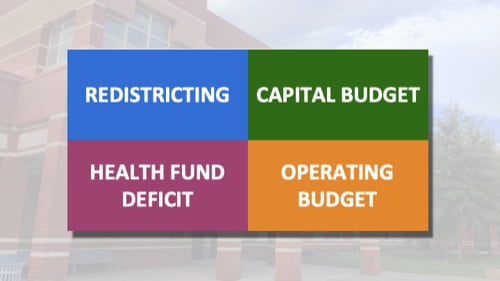
Defining Our Priorities
Again, these four major issues have impacted our school system and county in a very profound way. Through inextricably linked processes of redistricting, the Capital and Operating Budget processes, and our efforts to eliminate the Health Fund, we have clearly defined our priorities by putting people and equity first.
While these four areas drive our work and we have many challenges, we are an excellent school system and one with much to celebrate. And I want to talk briefly about that.
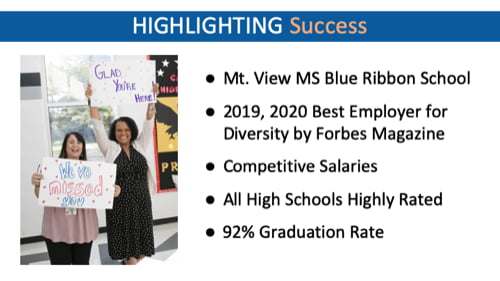
Highlighting Success
Every success realized is a result of the phenomenal teachers and staff working in our classrooms and across the school district. During our kickoff events at the beginning of the school year, I witness first-hand the passion and dedication that our educators bring with them into the classroom each and every day. It is common knowledge that Howard County is a destination county because of our schools – but our schools are only as good as the people who are teaching and tending to our children. Victories occur every day in the classroom and are only achieved because of the tremendous educators we have in Howard County.
Additionally, I am incredibly proud that Mount View Middle School was selected as a state blue ribbon school this year, and HCPSS was again named a Best Employer for Diversity by Forbes Magazine for the second year.
We offer competitive salaries for our staff to maintain and attract the best talent. Our families benefit from being able to send their kids to high schools that are consistently rated as the best in the state by various publications.
Our graduation rate continues to be one of the highest in the state.
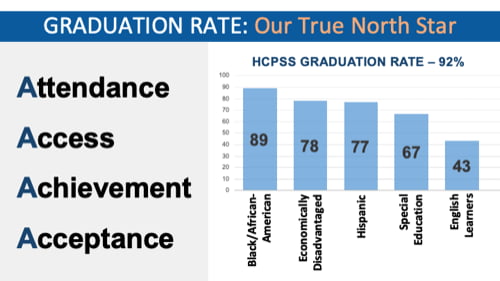
Graduation Rate
Our students overall continue to achieve at the highest levels. However, while we celebrate our 92% graduation rate, which is the highest among Maryland’s large systems, we cannot afford to be complacent. 8% of our students did not make it to graduation. As you can see by this chart, troubling achievement gaps remain and too many student groups lag well behind their peers.
We have made some progress in balancing student needs among our 77 schools through our recent redistricting progress, but further progress will require that we direct and equitably distribute sufficient resources.
You’ve now heard me talk about graduation rates every year since becoming Superintendent. The true measure of our success – our “True North Star” – is bridging the gap for those who are falling behind. The reality is that we are unable to achieve significant change in the graduation rate overnight, but we know what the factors are that affect it: attendance, access, achievement and acceptance. We have improved our student and school support processes and structures to provide better supports to school leaders and families because we know that achievement in all areas happens over time. All of this can not be done in just the 12th grade or even just in high school. That is why the initiatives and efforts I have discussed and the work we are doing spans across every level starting at birth.
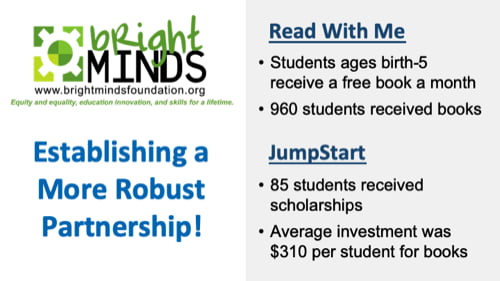
Bright Minds Foundation
I’d like to give a special thanks to the Bright Minds Foundation. Bright Minds is dedicated exclusively to supporting Howard County public schools and students. Over the last year we have asked Bright Minds for their support for several of our initiatives, and they have stepped up to the plate admirably. These projects include:
- Read with Me, a program that provides one book a month to children from birth to age five, and has grown countywide this school year after a successful pilot. More than 960 Howard County children have received free books to build a home library and expand supports and resources to ensure that children enter school ready to succeed.
- JumpStart – 85 JumpStart dual enrollment students have received scholarships from Bright Minds Foundation to help cover the cost of their books and course fees when taking classes on Howard Community College’s campus. The average investment per student last school year was $310. This scholarship is helping student develop skills, earn college credits, and explore career options.
The Bright Minds Foundation has existed as an important but unsung partner of HCPSS for many years.
They were established as an independent educational foundation in 2006. However, they have always worked in close partnership with HCPSS to support Howard County public school students, staff, and teachers. Their programs help drive education innovation, increase equity and access, and provide students skills for life.
Because of our shared commitment to these same goals, and our belief that Bright Minds serves both an important role in our community and the HCPSS family, we are exploring ways to take our partnership to the next level. This builds on great work that we’ve already been doing together for many years and enables our educational foundation to help many more students.
We look forward to sharing details of our discussions in the coming months.
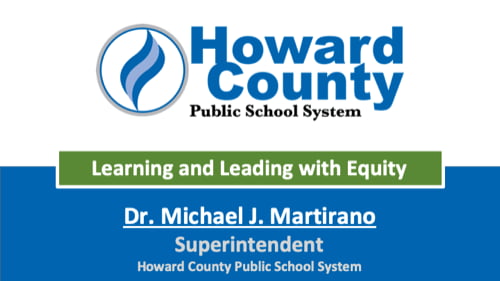 Slide 29
Slide 29Conclusion
As you can see, we are continuing to advance efforts to move the needle for all students. This year, we calibrated our focus on equity in every major undertaking including the completion of the largest redistricting process in Howard County’s history, the advancement of the proposed Capital and Operating budgets, and finalizing a plan to eliminate the Health Fund Deficit.
I appreciate the support that you provide to our students and educators and I thank you for being here this morning.